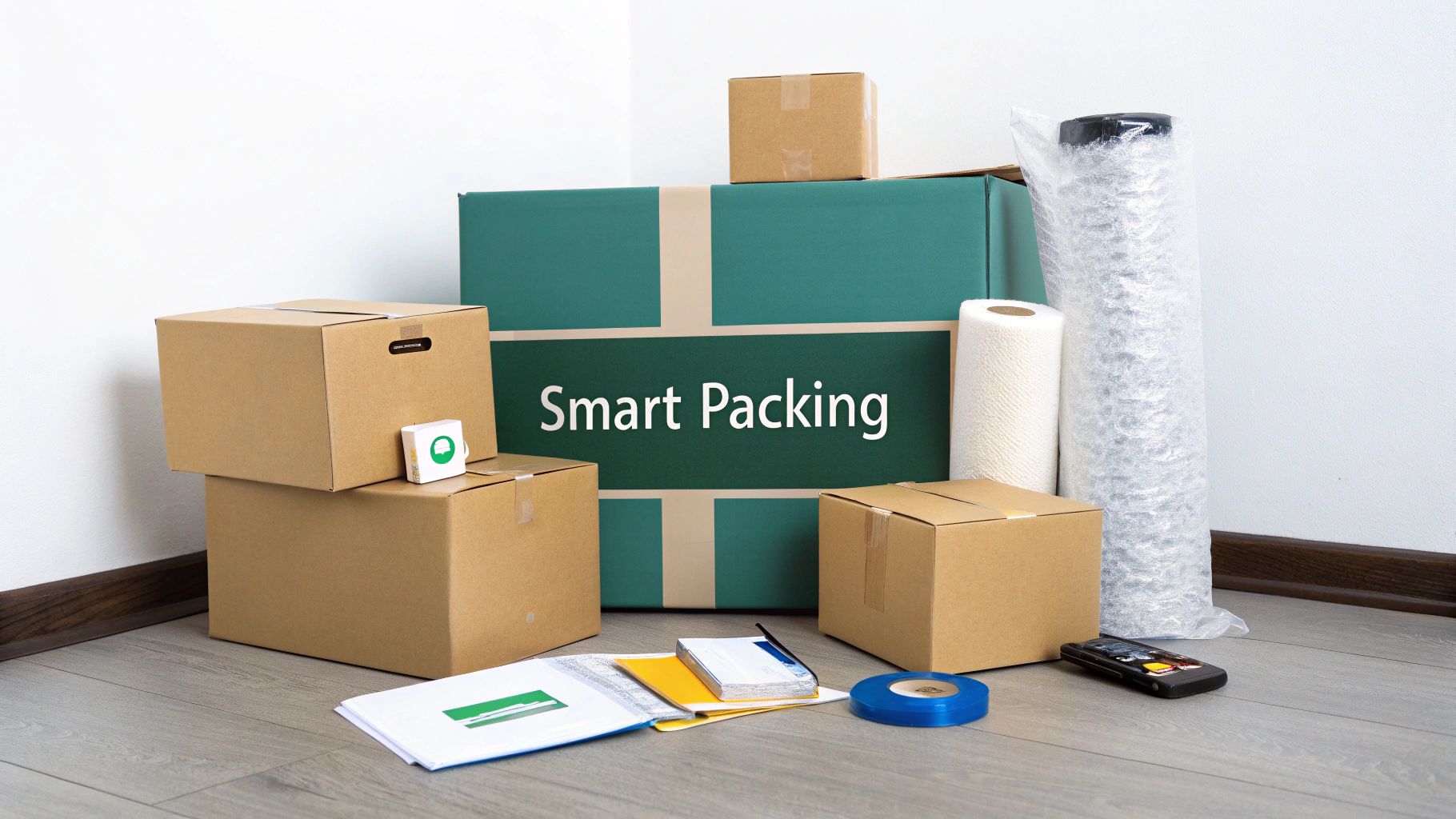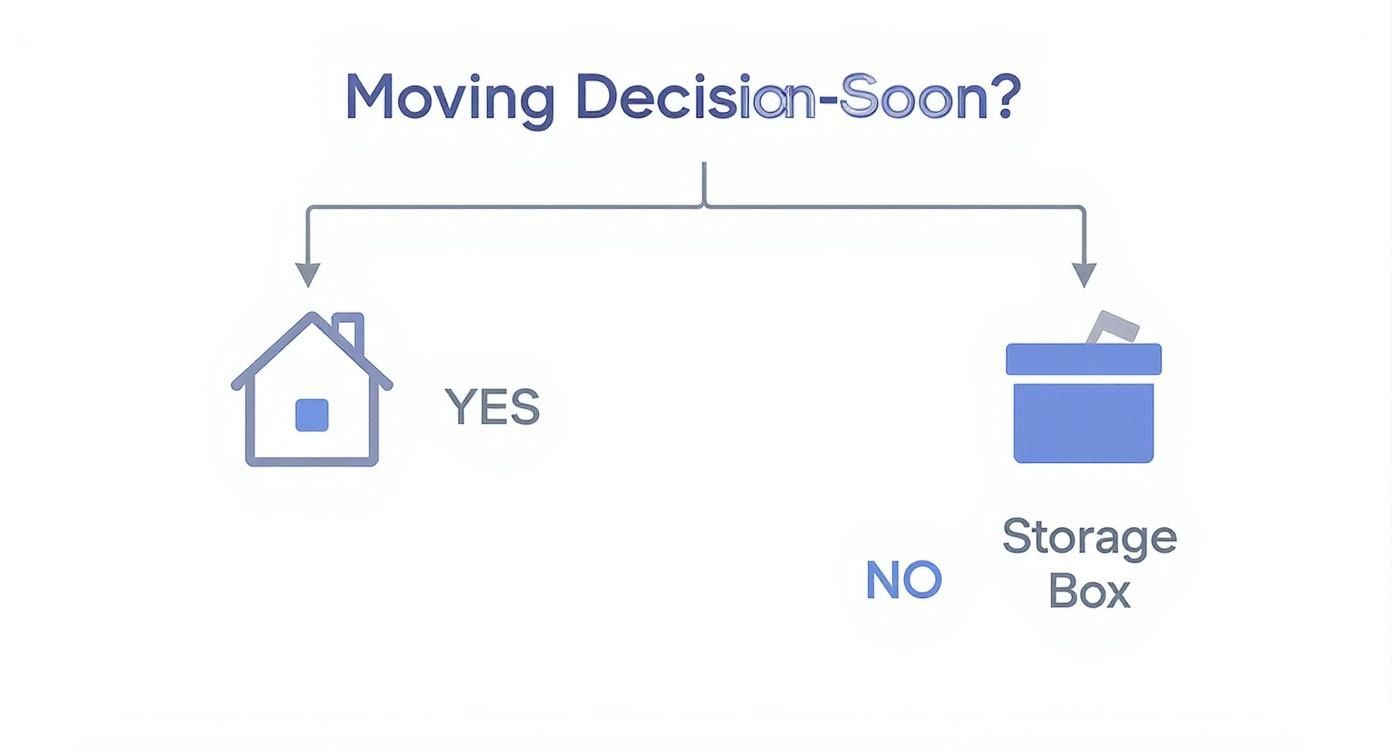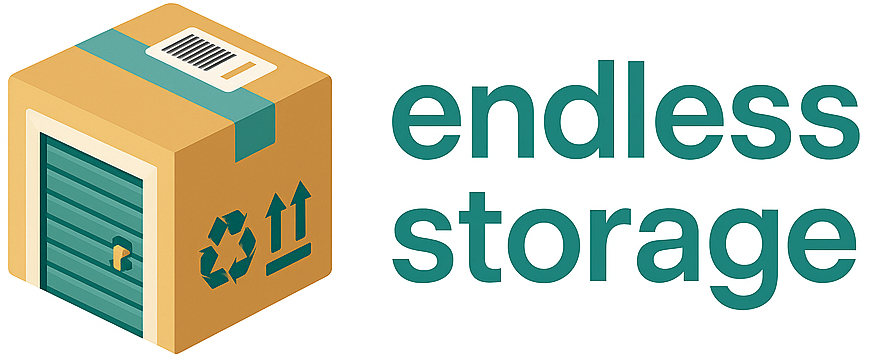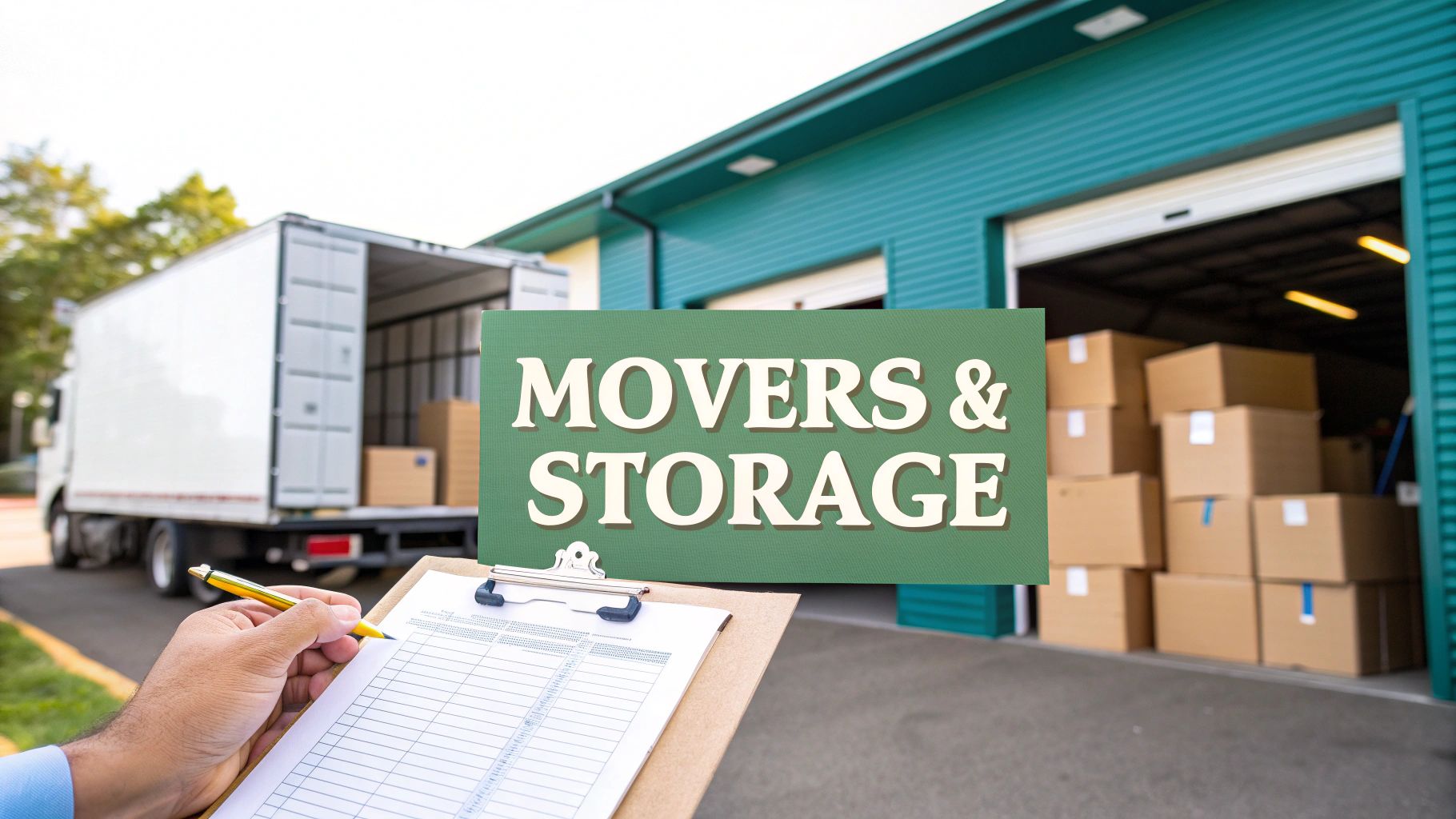Before you even think about getting quotes for a movers and storage service, the most important thing you can do is get a crystal-clear picture of what you actually need. Think of it as creating a blueprint for your move. This initial self-assessment is the bedrock for finding a service that fits your timeline, your budget, and your specific situation, making the whole process worlds smoother from the get-go.
Figuring Out Your Moving and Storage Needs

Diving into quotes without a solid plan is a lot like going grocery shopping when you're starving—you're guaranteed to end up with a cart full of things you don't need and a much bigger bill. Before you pick up the phone, take some time to think beyond just "how many boxes" and really dig into the scope of your move.
Are you downsizing and need a safe place for grandma's antique dresser? Maybe you're stuck in that awkward 30-day gap between leases and need to temporarily house everything you own. Or perhaps you're just renovating the kitchen and need the appliances and cabinets out of the way for a few months. Each of these situations calls for a totally different game plan.
This isn't just you, either. The need for flexible moving and storage is booming. The combined global market was valued at a staggering USD 52.3 billion in 2024 and is expected to almost double by 2034. With self-storage making up more than half of that, it's clear that needing a little extra space during life's transitions is more common than ever.
To get started, let's walk through a few questions to help you map out your move. Answering these before you talk to any companies will save you time, money, and a lot of headaches.
Self-Assessment Checklist for Moving and Storage
This checklist is your first step toward a more organized and less stressful move. With these answers in hand, you’ll be ready to have much more productive conversations with potential providers.
Get a Handle on Your Full Inventory
First things first: walk through your home, room by room, with a notepad or a spreadsheet and create a detailed inventory. This isn't just about counting chairs. It’s about being honest about what needs to move, what can be stored, and what you can finally part with. This exercise forces you to visualize the sheer volume of your stuff.
Pro Tip: Whatever you do, don't just guess how much storage space you'll need. A bad estimate can leave you paying for a half-empty unit or, even worse, scrambling for more space on moving day. To get a much more accurate idea of your needs, check out our guide on using a storage space calculator.
Once you have your master list, break it down into three simple categories:
- Going to the new place: The essentials you can't live without.
- Going into storage: Things you want to keep but don't have room for right now.
- Getting rid of: Anything you’re ready to sell, donate, or toss.
Pinpoint Items That Need Special Care
Next up, think about what's in the boxes. Some of your belongings need more than just four cardboard walls and a spot in a truck. Do you have delicate antiques, a pricey wine collection, or sensitive electronics?
Items like these often demand climate-controlled storage to shield them from extreme heat, cold, or humidity that can cause warping, mold, and permanent damage. Make a separate, non-negotiable list of these high-value or fragile goods. That way, you’ll know to specifically ask for the right kind of protection. A little foresight here can save you from a lot of heartache and costly replacements down the road.
How to Vet and Choose Your Moving Company
Once you've got a handle on what your move actually requires, it’s time to find the right people for the job. And let’s be honest, this is about more than just a quick Google search for "movers near me." You’re trusting a company with everything you own, so a little detective work is in order.
A great starting point is asking around. Tap into your network of friends, family, or even local neighborhood groups on social media. A personal referral is often the most reliable review you can get. After that, dig into online reviews on sites like Yelp or the Better Business Bureau. The key is to read the actual comments, not just glance at the star rating.
You're looking for patterns. Are people consistently praising the crew's punctuality and communication? That's a huge green flag. On the flip side, if you see multiple complaints about surprise fees, damaged furniture, or ghosting customer service, run the other way.
Verify Credentials and Insurance
Alright, you've got a shortlist of three to five promising companies. Now it's time to make sure they're legit. This step is absolutely non-negotiable; it's your main line of defense against scams and fly-by-night operators.
For any company crossing state lines, they are required to have a U.S. Department of Transportation (USDOT) number. Don't just take their word for it—you can look it up yourself on the Federal Motor Carrier Safety Administration (FMCSA) database. This check confirms they’re a registered, authorized carrier.
Next, you'll want to see proof of two key types of insurance:
- Liability Insurance: This covers your stuff if something gets damaged. It’s important to understand the different levels of coverage, from basic "released value protection" (which is minimal) to comprehensive "full value protection."
- Workers' Compensation: This is crucial. It protects you from being on the hook financially if a mover gets injured on your property.
Any professional, above-board company will have this paperwork ready to go. If they hesitate or give you the runaround, that’s your cue to cross them off the list.
It's easy to assume every moving company is a big, established brand, but that's far from the truth. The U.S. moving services industry, projected to hit $23.3 billion by 2025, is made up of over 7,600 mostly small businesses. This fragmentation makes doing your own homework absolutely critical.
Secure an Accurate Estimate
Never, ever accept a quote over the phone without some kind of visual survey. Reputable movers will always insist on either an in-home walkthrough or a detailed virtual tour to give you a precise, written estimate. This is the single best way to avoid nasty price hikes on moving day.
Pay attention to how the company representative conducts the estimate. A true professional will be thorough, asking smart questions about fragile items, tricky access points like narrow stairs or elevators, and your storage timeline. This is also your chance to grill them. For a complete list of what you should be asking, check out our guide on how to choose the right moving company.
Finally, lay out the written estimates side-by-side. Be suspicious of any bid that comes in dramatically lower than the others—it’s often a red flag for a scam or a sign that they’ll tack on hidden fees later. The goal isn’t to find the cheapest mover, but the one that offers the best value and gives you peace of mind.
Packing and Labeling for a Move and Storage

Let’s be honest, great packing isn’t just about getting things into boxes. It’s a full-blown strategy. It’s the one thing that can turn a chaotic, stressful move into a smooth, organized process. When you're dealing with both a new home and a storage unit, nailing your packing and labeling is non-negotiable.
The whole game starts with using the right materials. I know it's tempting to snag free boxes from the grocery store, but they just don't have the structural integrity for a move. Trust me on this. Invest in a set of high-quality, sturdy moving boxes in a few different sizes. It makes all the difference.
Essential Packing Materials Checklist
Before you tape up a single box, get everything you need in one place. Setting up a little packing station saves you from those frustrating last-minute runs to the store.
- Small, Medium, and Large Boxes: A classic rule of thumb: heavy items like books go in small boxes, and light, bulky things like pillows and bedding go in large ones.
- Specialty Boxes: Don't overlook these! Wardrobe boxes are a lifesaver for hanging clothes, and dish packs with built-in dividers are pure magic for protecting your kitchenware.
- Packing Paper and Bubble Wrap: Use plenty of paper for everyday items and save the bubble wrap for the really delicate stuff, like electronics and glassware.
- Packing Tape: You will need way more than you think. Get a few extra rolls of strong, quality packing tape.
- Markers and Labels: Sharpies are a must, but a real labeling system is even better. More on that in a second.
A Smarter Way to Label Everything
Scribbling "Kitchen Stuff" on the side of a box with a marker is a recipe for disaster. An effective labeling system is your personal roadmap for unpacking and, just as importantly, for finding that one specific thing you need from storage six months from now.
When your movers and storage service shows up, your labels need to tell them exactly what to do. No questions asked.
Every single box should clearly show three things:
- Destination: Where is it going? "Main Bedroom," "Kitchen Pantry," etc.
- Contents: What’s actually inside? Be specific. "Blender, Toaster, Coffee Mugs," not just "Kitchen."
- Priority: Does this box go to STORAGE or the NEW HOME?
This dual-destination labeling is absolutely critical. It stops movers from having to guess and ensures the right boxes land in the right place. For a complete guide on setting up a foolproof system, check out our deep dive on how to label boxes for moving and storage.
Pro Tip: Color-coding is your best friend here. Grab a roll of blue painter's tape for everything going to the new home and red tape for all the storage boxes. It’s a quick visual cue that speeds everything up on moving day.
If you want to get really organized, consider ordering some custom labels. Pre-printed labels with room names and big, bold "STORAGE" indicators save a ton of time and keep everything looking clean and uniform.
Tackling Furniture and Electronics
Your big-ticket items need some special attention. Whenever you can, disassemble furniture—take the legs off tables, break down bed frames, and remove headboards. It saves a surprising amount of space in the truck and storage unit and seriously cuts down on the risk of dings and scratches.
Always put screws, bolts, and other small hardware into a labeled plastic bag and tape it securely to the largest piece of the furniture it belongs to.
Electronics are vulnerable to both static and impact. The original box is always the best option if you still have it. If not, wrap things like TVs and computers in thick blankets or bubble wrap, giving extra attention to the screens. And here’s a tip that will save you a massive headache later: snap a quick photo of the back of your electronics before you unplug all the wires. You’ll thank yourself during reassembly.
Coordinating the Logistics of Your Move
You’ve got a plan and you've picked your moving partner. Now it’s time to wrangle all the moving parts. This is where a clear timeline and solid communication become your best friends, making sure your movers and storage service can work their magic on the big day.
Think of the week before your move as the final dress rehearsal. Give your moving company a quick call to confirm all the details. Run through the arrival time, double-check the addresses for both your new home and the storage facility, and go over any special instructions one last time. This simple phone call can prevent a world of headaches and ensures everyone is on the same page.
To stay on top of everything, using a comprehensive moving and storage planner can be a real game-changer, keeping all your details in one organized spot.
Setting the Stage for Moving Day
The day before the crew shows up, it's time to prep your home for action. Clear a wide path from the front door to every room they'll need to access. This means getting rid of any tripping hazards like area rugs, stray cords, or that one box you forgot to move. If you have kids or pets, it’s a really good idea to arrange for them to spend the day with a friend or family member. It keeps them safe and seriously lowers the stress level for everyone.
You'll also want to pack an "essentials" box. This is the box that stays with you, not on the truck.
- Important Documents: Things like passports, birth certificates, and all your moving paperwork.
- Medications: Any daily prescriptions for you, your family, or your pets.
- Basic Toiletries: Toothbrushes, soap, a towel, and a change of clothes will feel like a luxury after a long day.
- Chargers: Don’t let your phone die mid-move. Pack chargers for all your essential electronics.
- Simple Tools: A box cutter, a basic screwdriver set, and Allen keys will make you feel like a hero when it's time to reassemble furniture.
This one small step saves you from that late-night, frantic search for toothpaste. For a more detailed schedule, take a look at our complete moving checklist and timeline.
One of the most important documents you'll see on moving day is the bill of lading. This is your legal contract with the moving company. Before you sign anything, read it carefully. Make sure the inventory list is accurate and the final price matches your original estimate.
When the movers arrive, your main job is to play traffic cop. With your master inventory list in hand, you can direct them confidently. Use your clearly labeled boxes to point them to the right spots—this pile is heading to storage, that one goes to the new house. Staying organized and communicative is what transforms a day that could be chaotic into a smooth, predictable process.
Traditional vs. Modern Storage Options
When you need a movers and storage service, the kind of storage you pick can make or break your entire moving experience. It's not just about finding a local place with a roll-up door anymore. These days, your choices really boil down to two main camps: good old traditional self-storage and the newer, more modern valet services.
Traditional self-storage is probably what comes to mind first: you rent a private unit at a secure facility and pay for it monthly. You're in charge of getting your stuff there, packing the unit, and grabbing things when you need them. The big win here is direct access. It's perfect if you think you'll be popping in frequently for things like holiday decorations or work gear.
Then you have modern valet or per-box storage services, like those offered by Endless Storage. They completely flip the script. Instead of you driving to your storage unit, the storage comes right to your doorstep. They provide the boxes, you pack them up, and they handle the pickup, storing everything in a secure, often climate-controlled, facility.
This simple visual breaks down the core question you need to ask when deciding what to store versus what to move.

Answering that one question is the key to figuring out which storage model makes the most sense for the items you aren't taking with you right away.
Traditional Self-Storage vs. Per-Box Valet Storage
Let's put these two options head-to-head. Each has its own strengths, and the right choice really depends on what you value most—convenience, access, or cost. This table breaks down the key differences to help you decide.
Ultimately, it's a trade-off. Traditional storage gives you more hands-on control, while valet storage is all about saving you time and effort.
Which One Is Right for You?
The real difference boils down to a classic case of convenience versus control. Valet storage is the ultimate hands-off solution, a lifesaver for anyone living in a tight city space or just dreading the idea of hauling boxes. You simply manage your stored items online and schedule a delivery when you want something back. The catch? You give up that instant, 24/7 access.
Key Takeaway: There's no single "better" option—it's all about what fits your life. If you love a hands-off service and are short on space, valet storage is a game-changer. But if you see your storage unit as an extension of your garage, traditional is the way to go.
Let's look at a few real-world examples of where each service really shines.
Traditional Self-Storage is perfect for:
- Small business owners who need to grab inventory on a regular basis.
- Hobbyists with bulky equipment, like woodworkers or classic car buffs.
- Families who want to swap out off-season gear like bikes, skis, or kayaks.
Modern Valet Storage is a great fit for:
- Apartment dwellers in big cities who are fresh out of closet space.
- College students who need to store their dorm room essentials over the summer.
- Anyone downsizing who wants to keep sentimental items they don't need daily access to.
By thinking through the convenience, cost, and access of each model, you can pick a storage solution that feels like a natural part of your moving plan instead of another headache.
Frequently Asked Questions
Even after mapping out your entire move, it's totally normal to have a few questions lingering. This is where we tackle the most common ones we hear, giving you straight answers to help you nail down those final details with confidence. We’ll cover everything from how costs are calculated to how you’ll get your stuff back when you need it.
How Is the Cost of a Movers and Storage Service Calculated
The final number on your moving quote is really a mix of a few key things. Movers will typically look at the total weight or sheer volume of your belongings, how far they need to haul everything, and the size of the storage space you'll be renting. Naturally, how long you plan to keep things tucked away in storage is another big piece of the puzzle.
Any extra services you add on will bump up the price, too. Things like professional packing, special handling for that grand piano or delicate artwork, or needing more than basic insurance will add to the bottom line.
Crucial Advice: Always, always insist on a binding estimate in writing. Get this only after the company does an in-home or virtual walkthrough. This locks in your price and protects you from those nasty surprise charges on moving day—a classic move by shady operators.
To get a better handle on the storage part of the bill, which can swing wildly depending on your city and unit size, check out our deep dive on how much storage costs. It'll help you build a much more realistic budget.
What Kind of Insurance Do I Need
This is one of the most critical questions, and honestly, it gets overlooked way too often. Federal law requires moving companies to offer basic released value protection for free. But here's the catch: the coverage is minimal, often paying out a measly $0.60 per pound per item. If your 100-pound solid oak dining table gets smashed, you’d only get $60 back. Yikes.
For real peace of mind, you have a couple of better options:
- Full Value Protection: You can buy this directly from the moving company for an extra fee. It holds them responsible for the replacement value of anything that gets lost or broken.
- Third-Party Insurance: You can also purchase a separate moving insurance policy from an outside company. Sometimes these plans offer more comprehensive coverage.
Before you spend a dime on extra insurance, though, make a quick call to your own insurance agent. Find out if your current homeowner's or renter's policy already covers your belongings while they're in transit or sitting in a storage facility. You might already be protected.
How Can I Access My Items in the Storage Unit
How you get your stuff back is a huge deal, and it really separates the different types of storage services out there. Make sure you get this clarified before signing anything.
If you go with a traditional self-storage facility, you’re in the driver's seat. You can usually drive right up to your unit during their business hours, unlock it, and grab whatever you need. It offers the most freedom and flexibility.
The new valet or per-box storage services work differently. You have to schedule a delivery through their app or website. This usually means giving them 24-48 hours' notice, and you’ll likely pay a fee for the return delivery. Always confirm the exact access rules and any costs involved before you commit.
Ready for a storage solution that comes to you? Endless Storage offers convenient, by-the-box storage with nationwide pickup and delivery, taking all the hassle out of the process. Get Your Free Quote Today!
Frequently Asked Questions
Unveiling the Secrets to Effortless Storage
Endless Storage is available nationwide. You pick a plan, tell us where to pickup, and we'll send a UPS van to collect, whichever state you're in.
Your shipping label will be sent to your email within a few minutes, if not instantaneously. It can also be accessed through your customer profile.
Your box will be shipped to one of our climate controlled self storage facilities in our closest self storage facility. Our manager will accept your package, notify you that your box has been received, and securely stored. Only our managers will have access to Endless Storage boxes.
Email us at admin@endless-storage.com click to live chat with us, or send us a message below.
Never! We're committed to transparent pricing with no surprises. You'll lock in your rate with no hidden fees and no long-term contracts.
Fast access guaranteed! Your boxes will arrive at your doorstep within 48 hours of requesting them back. Need to check on delivery? We provide tracking information for complete peace of mind.
Totally flexible! Store month-to-month with no long-term commitment and cancel anytime.
Everything's online! Use your account dashboard to:
• Set up automatic monthly payments
• Request box returns
• Update your address
• Order additional boxes
• Track shipments
Your boxes are insured up to $100 each. Our customer service team will help you file any necessary claims and resolve issues quickly.
Don't worry – we'll email you right away if there's a payment issue. Your items stay safe, though you may have temporary service interruption or late fees until payment is resolved.
When you request our free storage kits, you'll have 30 days to send in your boxes to activate your 3 months of free storage. Think of it like starting a gym membership – your activation window begins when you receive your kits, and your full free trial begins once you send in your first box. During your free months, you'll experience our complete storage service at no cost.
Your 30-day activation window begins when you receive your storage kits. We'll send you an email confirmation when your kits are delivered, marking the start of your activation period.
If you haven't sent any boxes for storage within your 30-day activation window, your free trial will expire and we'll begin charging the regular monthly rate of $9.99 per box. This helps ensure our storage kits go to customers who are ready to use our service.
A box costs $9.99 per month to store (plus sales tax). This price includes free shipping for standard boxes under 50 lbs. and smaller than 16"x16"x16"
Log into your Endless Storage account, locate the box you would like returned, and simply click Return My Box.
Yes, each box stored with us is insured for up to $100 throughout transit as well as the duration of storage within our facilities.
Your box will be at your doorstep within 48 hours of you requesting it back.
Store 10+ boxes? We'll pick them up for free! After your purchase, we'll contact you to schedule a convenient pickup time and arrange UPS collection.
We trust UPS with all shipments, and every box includes $100 insurance coverage. You'll receive tracking information to monitor your items' journey.
Yes! Visit any of our locations by appointment. Just bring a photo ID matching your customer profile.
For everyone's safety, we can't store hazardous materials, firearms, or perishables. All items must fit within our standard boxes.
It's easy! Order your storage kit online, and we'll ship it to you within 1-2 business days. Your shipping labels will be emailed instantly and available in your account.
We're here to help! Email us at admin@endless-storage.com, use our live chat, or send us a message through your account.
To cancel your storage service with Endless Storage, please email your cancellation request to admin@endless-storage.com. Our team will process your request within 2 business days and confirm your cancellation via email.
We understand packing takes time. However, to maintain your free trial benefits, you'll need to send at least one box within the 30-day activation window. If you need more time, you can always start with one box to activate your trial and send the rest later. You can always reach out to admin@endless-storage.com if you have any issues or concerns.
When you request our free storage kits, you're starting a 30-day window to begin using our storage service.
To avoid any charges, simply send at least one box for storage within 30 days to activate your 3-month free trial. If you decide not to use our service and don't send any boxes within the 30-day window, a one-time $50 fee will apply to cover the costs of materials and shipping. This helps ensure our storage kits go to customers who are ready to use our service.
Think of it like reserving a hotel room – we're setting aside space and sending specialized packing materials for your use. The fee only applies if you request materials but don't begin storage, similar to a hotel's no-show charge.

